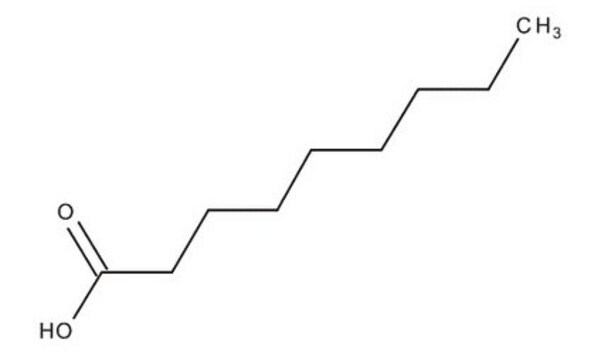N29902
Nonanoic acid
96%
Synonym(s):
Acid C9, Pelargonic acid
About This Item
Recommended Products
vapor density
5.5 (vs air)
Quality Level
vapor pressure
<0.1 mmHg ( 20 °C)
assay
96%
form
liquid
expl. lim.
9 %
refractive index
n20/D 1.432 (lit.)
bp
268-269 °C (lit.)
mp
9 °C (lit.)
density
0.906 g/mL at 25 °C (lit.)
SMILES string
CCCCCCCCC(O)=O
InChI
1S/C9H18O2/c1-2-3-4-5-6-7-8-9(10)11/h2-8H2,1H3,(H,10,11)
InChI key
FBUKVWPVBMHYJY-UHFFFAOYSA-N
Looking for similar products? Visit Product Comparison Guide
signalword
Warning
hcodes
Hazard Classifications
Eye Irrit. 2 - Skin Irrit. 2
Storage Class
10 - Combustible liquids
wgk_germany
WGK 1
flash_point_f
278.6 °F - Pensky-Martens closed cup
flash_point_c
137 °C - Pensky-Martens closed cup
ppe
Faceshields, Gloves, Goggles, type ABEK (EN14387) respirator filter
Choose from one of the most recent versions:
Already Own This Product?
Find documentation for the products that you have recently purchased in the Document Library.
Customers Also Viewed
Protocols
In this study, SPME was used for the analysis of free fatty acids in Parmesan cheese using a 65 μm Carbowax/divinylbenzene (DVB) SPME fiber. Headspace extraction of the cheese sample was conducted at 65 °C for 15 minutes and analyzed by GC with FID detection. SPME is ideal for analyzing the volatiles associated with solid food samples. The phase chemistry of the Nukol GC column provides excellent peak shape of acidic compounds.
Our team of scientists has experience in all areas of research including Life Science, Material Science, Chemical Synthesis, Chromatography, Analytical and many others.
Contact Technical Service






